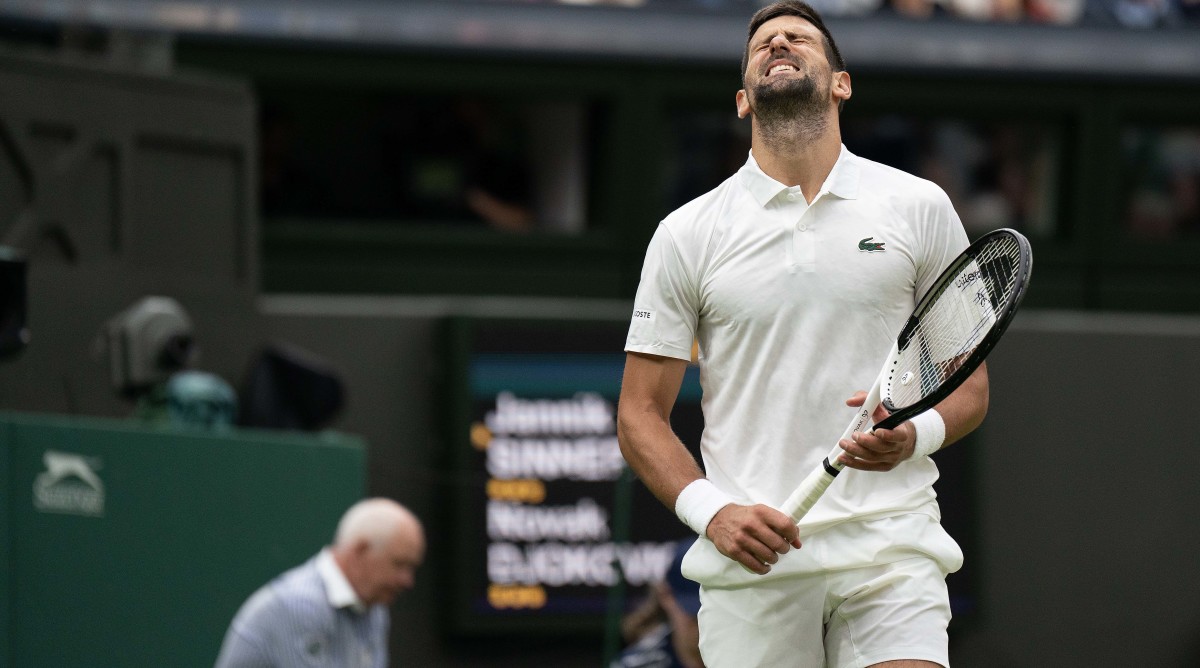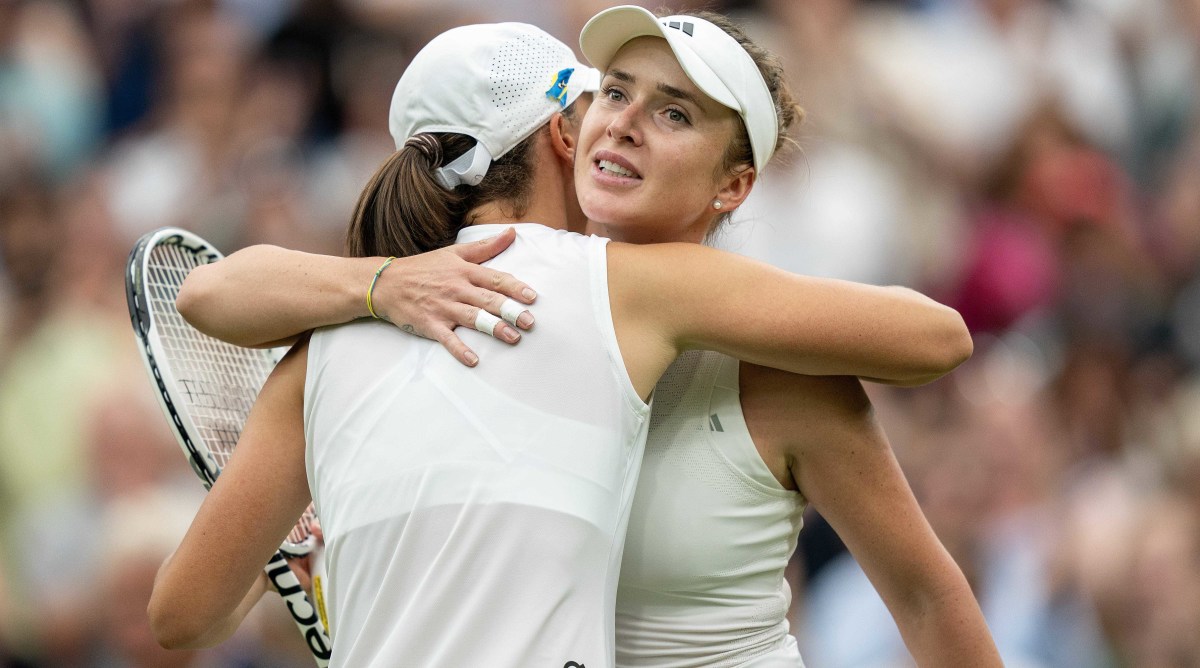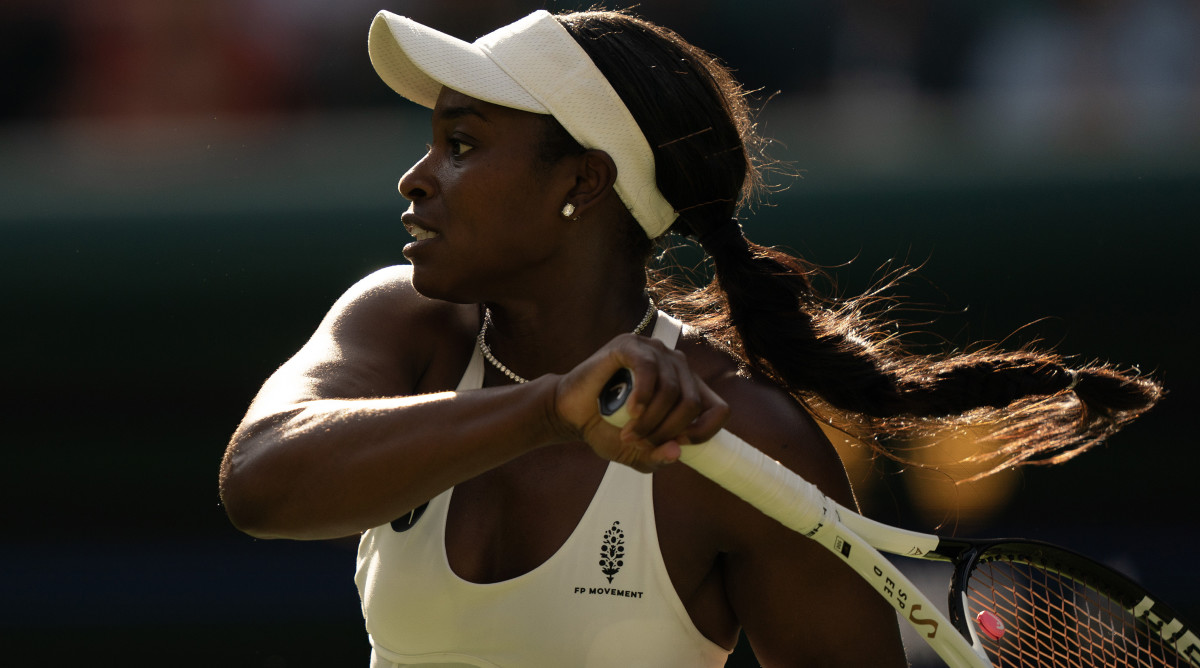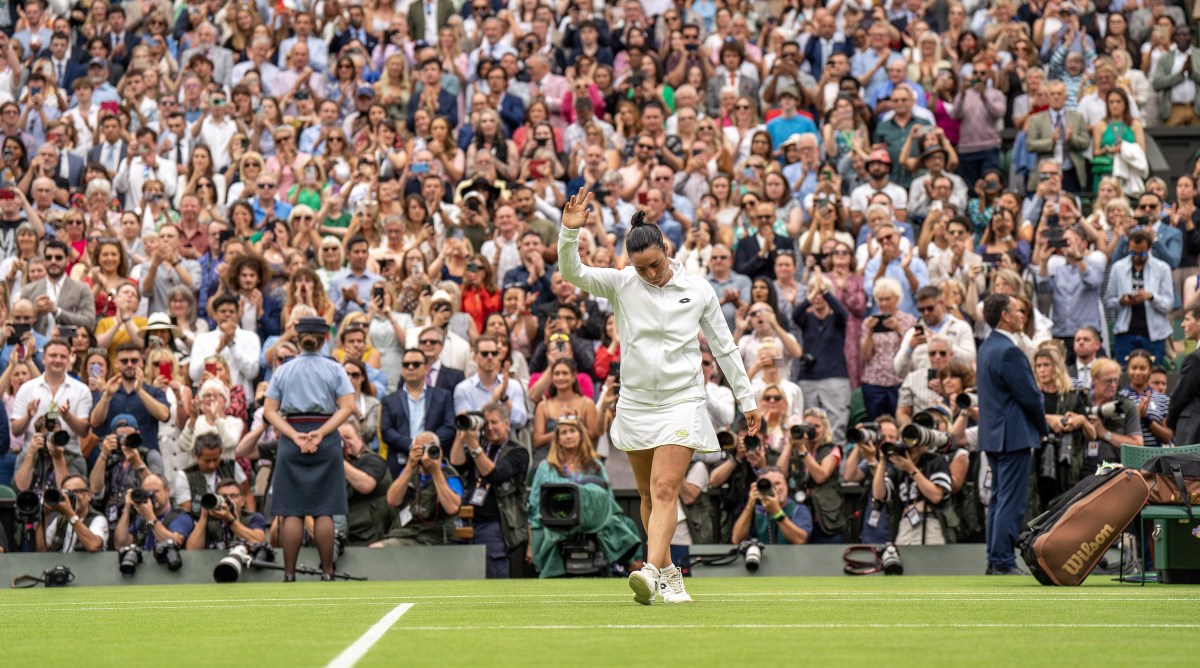50 Parting Thoughts From Wimbledon 2023

Emptying the notebook and notes app from Wimbledon 2023….
1. What is sweeter than a sporting event lives up to its hype?… There are tennis matches. There are classics. Then, there is whatever today was. In a spellbinding five-act theatrical of a men’s final, Carlos Alcaraz beat Novak Djokovic 1-6, 7-6, 6-1, 3-6, 6-4. Barely five weeks ago in Paris against Djokovic, Alcaraz was undone by “tension.” Today he took the pressure and—with all sorts of stress, with supremacy on the line, with his king watching—he won in five sinuous sets. It’s the second major of his career. And Lord knows how many more are coming?
2. All hail Markéta Vondroušová, the first unseeded women’s champion. The casual fan might not have heard of her. Seasoned tennis fans know better—she’s long been a vexing opponent, a clever and deceptively powerful lefty who reached the Roland Garros final in 2019 and won an Olympic silver medal in Tokyo in 2021. Despite the most modest of track records on grass—heading into the season she had a 2-10 career with green blades underfoot—she mastered the stuff this summer. The No. 42—and No. 7 Czech player!— to start the tournament, is now in the top 10.
3. In a perfect world, Ons Jabeur leaves here smiling, content that she won six matches, and beat two of the world’s top three players. But ours is an imperfect sphere. And Jabeur leaves devastated, losing her third major in 12 months, committing scads of errors and letting her nerves consume and subsume her….
4. An extended applause for Djokovic. He was beaten on Centre Court for the first time in more than a decade. But it took a player 16 years his junior playing lights out for much of the afternoon. This, after Djokovic was barely tested for six rounds. What a generational athlete this is. We are lucky to see him in his prime. Which might well be now.

5. Daniil Medvedev is a splendid player, improved on grass—and a blazing tennis personality. He is also stubborn in the extreme. Sometimes this is a virtue: He’s a player who makes a commitment and sticks to it. Sometimes, it’s to his detriment: The idea that he would stand deep to return on grass is madness. He paid the price against Alcaraz in the semis, giving up so much real estate and getting the business end of a tennis lesson.
6. Quite a year for Aryna Sabalenka. She wins the Australian Open. She reaches the Roland Garros semis and holds match point … only to lose. Here, a match from reaching No. 1, she reaches the semis, leads a set and 4–2 against Jabeur and loses.
7. Elina Svitolina did her (and her beleaguered country) proud, reaching the semis. She fell flatly to flat-hitting Vondroušová in the penultimate round. But not before beating four major champions, including No. 1 Iga Świątek. One angle to this story: You can draw a direct line between her life changes (motherhood/marriage/country barbarously invaded) and a reinvented, bolder, more offensive, less risk-averse tennis game.
8. Chris Eubanks did himself proud reaching the quarterfinals (and, in the We-Hate-Body-Fat Match, coming within a few points of beating Medvedev to make the semis). He comported himself so professionally—while soaking in the moment and appreciating this unlikely ascent. He leaves a transformed player; he’ll be seeded at the U.S. for starters; he won’t be playing qualifiers for the foreseeable future. He also must be an inspiration to so many players who, like him, started the year outside the top 100.
9. Following the men’s final, the women’s doubles final played on Centre Court. And tennis karma did its thing as a pair of 37-year-olds Barbora Strýcová, back from maternity leave, and crafty Hsieh Su-wei, back from retirement took another title. How do they not keep it going in New York? In the men’s doubles, Neal Skupski (LSU!) and Wesley Koolhof, the top seeds, took the title.
10. The juniors event was beset by rain and wind, but the final results are noteworthy. Clervie Ngounoue, a 16-year-old American, won the girls. Henry Searle became the first British boy to win the title since 1962.
And 10a: Move over, Alcaraz; Tokito Oda won the men’s wheelchair title and he is 17….Move over Djokovic; Diede de Groot won the women’s wheelchair for her 11th (!!) consecutive major.
11. It wasn’t Svitolina, but there was a Ukrainian champion. Lyudmyla Kichenok teamed with Mate Pavić to win the mixed.
12. This is a re-up from years past. But part of our duties at these events entails interviewing players for Tennis Channel. And it restores your faith in this sport. Older, younger, American, “international,” male, female, stars, less accomplished … the players are, collectively, awesome. And wildly diverse as people. A conversation with, say, Eubanks is nothing like a conversation with, say, Donna Vekić. Carlos Alcaraz says, “To be the best, you need to beat the best.” Alexander Bublik says he dreams that his upcoming opponents retire, and he won’t have to face them. Point: The players are great. Too often it’s the suits who create the problems. More on this below.
13. With the player ban reversed, focus turned to the absence of handshakes between Ukrainians and Russians/Belarusians. Here comes Pete Bodo off the top rope with the best column yet on the issue. The money line: “It now seems like the policy reversal may do more to rally support for Ukraine than did a ban. The handshake controversy helps keep the horror and atrocities committed by the Russians in public view.”
14. Wearing the flag of her opponent’s country on her hat—there’s a sight you don’t see every day—Świątek, the top seed, fell in the quarters to Svitolina. (Speaking of rare sights: Not often do you see a player look and speak reflexively and intensely at their psychologist, not at their coach or parents, during critical moments.) Świątek was philosophical in defeat. She leaves grass, the lone surface that troubles her. The U.S. Open is still six weeks away, and one imagines Świątek will be the favorite to defend her title. Maybe then Netflix will devote more time to her?

15. It has become abundantly clear—even before Billie Jean King’s strange and surprising imprimatur—that, fraught as it may, Saudi Arabia is about to emerge as a power in tennis. (Ah, the great whirring turbine of commerce.) The question is one of form. Will the Private Investment Fund ladle capital into the sport, backing the tours in exchange for, say, a 1000-level event on an already-crammed calendar? Or will we see a LIV-style rival, taking advantage of the Bosch canvas that is (oxymoron ahead?) tennis governance? That is, imagine if the Saudis cozy up to Tennis Australia, deal with the financial drag that is the United Cup, strike a deal with some top players and/or the entire PTPA, and … voilà, a competing entity? Watch this space, as they say.
16. Saudi-adjacent … even—maybe especially—for those of us who care deeply for women’s tennis, it’s hard not to have profoundly deep concerns about the WTA’s financial future (and present). I wrote about the WTA’s distressed and distressing financial picture the other day here.
17. Coco Gauff is 19, squarely in the top 10 and is as well-adjusted and self-possessed a young adult as you could hope to find. But for a player ordained to win majors, her stock is in a bit of decline. And her technically flawed forehand—her extreme grip is such that she uses the same face of the racket to hit forehands and backhands—is an issue. The quest for a coach is on. Or coaches. What if she kept a traveling coach, hired a technical coach and maybe someone like Brad Gilbert—who has had a conversation with the camp—joins as well?
18. Not to keep banging on about this … but still marveling that the two breakout stars of Wimbledon 2023 have been a 6'8" male from Atlanta, age 27, who played at Georgia Tech; and a winsome 16-year-old Russian woman who plays with fury but might not be able to board a ride at Six Flags. We speak, of course, of Chris Eubanks and Mirra Andreeva. Tennis has its issues and dysfunction. But its diversity—biodiversity, ethnic diversity, path diversity—is really something to behold.
19. Andrey Rublev and Jessica Pegula are both splendid players. Between them, they are now a combined 0–14 once reaching major quarterfinals. The problem with this is the compounding. Who was it that said psychic wounds are the hardest to clot? On the plus side, Rublev won Shot o’Tournament. And Pegula won Dunk o’ Tournament.
20. Pet peeve: withholding opinion about someone because you happen to have had a favorable personal experience. “I can’t say anything bad about Mussolini/Harvey Weinstein/Marie Antoinette because (s)he’s always treated me well.” No, actually, you can. Someone can be objectively rotten, even if they were never specifically rotten to you. (The converse is true, too.) With that as a preamble, I will now commit the same crime. I have interviewed Holger Rune—tennis’s alleged bad boy/cartoon villain—several times in recent weeks. He has been personable. He has been respectful. He has been funny. He has been uncommonly thoughtful in his responses. (And he wants no-ad scoring, to make tennis more fan friendly.) If this is a bad boy, we’re doing O.K. here, folks.
21. Budding tennis rivalry: the dueling Queen Cities, Charlotte versus Cincy. The fight of course—apart from vinegar-based barbecue over seven-way chili—pits the cities against each other in the bid to host the mixed tennis event preceding the U.S. Open. Charlotte has already approved more than $100 million for real estate and facilities. Cincinnati will make a counteroffer. Important to note: Ben Navarro bought the sanction, not Cincy per se. This isn’t the Oakland A’s carpetbagging to Las Vegas. Even if there’s an announcement tomorrow, Charlotte won’t be ready for years. So pull up a seat …
22. Starting a tennis event—one without lights and with a mandated curfew—at 1:30 p.m. is madness. Doing so because the members of your club prefer lunch before tennis is, as the kids say, kinda baller. Look for the Centre Court sessions to begin earlier next year, eliminating, one hopes, the schedule backup we saw in Week 1.
23. If the USTA is going to exist major to major and assess the state of affairs based on a few results, it must be fair about it. Lots of gushing press releases and social media postings about the Americans’ presence and success at Roland Garros. Here? Only one American qualified (and she is the most recent American major champ!). And four of the top U.S. players—all seeds—Coco Gauff, Seb Korda, Taylor Fritz and Ben Shelton lost in Round 1 or 2, while Sloane Stephens was up a set and 5–2 on Donna Vekić and failed to close.

24. Five players that didn’t escape Week 1 but impressed nonetheless: Pedro Cachín, who acquitted himself well against Djokovic. Arthur Fery, the 5'8" Stanford star who played Medvedev on Centre Court. Alexandre Müller of France who held his own against Alcaraz. Sonya Kenin, who looks to be back in some form, if not Major-winning form. Varvara Gracheva (of France, not Russia), who was a game from upsetting Sabalenka.
25. Yes, it helps to be flush with cash. But this event manages to improve and upgrade each year—the interview theater, the player tunnel to the indoor facility, the new lounges are among this year’s touches—while still leaning into history.
26. Random factoid: Entering the year, the respective earnings of married couple Gaël Monfils and Svitolina were 1% apart, both with a little more than $21 million. She has edged ahead by more than $1 million.
27. As often as we talk about tiebreak records—and Djokovic’s dominance—what about the players who thrive at 5–5? (“Who wants it more?” as we cliché-prone hacks inevitably ask.)
The good folks at Hawk-Eye kindly pulled for me this snapshot of the ATP. Note these winning percentages once sets go to 5–5. Wow.
Overall top five: 451–147: 75%
Alcaraz: 31–7: 82%
Djokovic: 186–99: 65%
Medvedev: 85–12: 88%
Casper Ruud: 63–14: 82%
Stefanos Tsitsipas: 86–15: 85%
28. Note to players: Years later, fans recall incidents of sportsmanship, good and bad, whether it’s Chrissie and Martina sharing food before a final, or Roddick conceding a point, or Tom Gorman retiring at match point because he knew he wouldn’t be fit for the next match, or players ”lying and fabricating” and failing to cop to a double-bounce. One small act plays this outsized role in your legacy. Pegula’s decision to challenge her own serve—called good; she thought, correctly, that it was out—tells us as much about her as any title. And it will age well. Good on her.
29. This is neither a compliment nor an old-guy critique … but what do Bublik, Nick Kyrgios, Vondroušová and Sabalenka have in common? Can we see some data here correlating “players with tattoo sleeves” and “players with wild variance in their games/results?”
30. Out: the Royal Box. In: coming to Wimbledon as a common fan. There’s something special about sitting behind Centre Court as a guest in the Royal Box. But there are rules about attire and phone usage and an expectation you’ll take tea between matches. As a result, plenty of celebrities have gently declined the Royal Box and have been coming incognito. This event’s fans include Katy Perry, Orlando Bloom, Jon Bon Jovi, Hugh Jackman, Shakira, an NFL owner and Lindsey Vonn.
31. Who is old enough to remember the underarm serve? Last year’s voguish shot—and bogus debate topic—was a nonissue in 2023. That is, until Alex Davidovich Fokina said, “Hold my tinto de verano.” In a fifth-set match tiebreak, ADF was leading Rune 8–5, two points from a big win. After losing three straight points, ADF suffered an all-time brain cramp and unfurled a feeble underhand serve—absent disguise or much spin—and, stranger still, charged netward. Rune was dumbfounded (in a happy way) but not so much so that he didn’t smoke a winning return. Rune then closed for 10–8, but mouths were still agape about the previous point. What happened? In one of the all-time great bits of withering self-assessment, Davidovich Fokina explained himself thusly: “I s--- myself.”
8-8 in the tiebreaker.
— Wimbledon (@Wimbledon) July 8, 2023
Who expected Alejandro Davidovich Fokina to do an underarm serve? 😯#Wimbledon pic.twitter.com/2ki8QOqkXz
32. Speaking of match tiebreaks, there’s something instructive here. Tennis has these spirited debates. Over format. Over coaching. Over dates. Over equal prize money. “If I could change one thing about this sport, it would be X.” Then the change comes, and it is quickly normalized.
33. Davidovich Fokina’s underarm serve was the talk of the session. Eubanks alluded to it in an interview on ESPN. It figured prominently in the postmatch press conferences. Podcasts alluded to it days later. Yet it did not warrant a replay on the in-house broadcast (the feed that all networks use). Whether it’s cultural differences or simply bad decision-making, Wimbledon’s television production is, at best, shaky. Way too often, there are no replays of extraordinary shots and points. When they do occur, often they use the wrong camera. (Crazy thought: If there’s an extraordinary point, show both players, not just one.) Cameras linger way too long on random fans—and fans caught yawning—sometimes while the ball is in play. Remember, this is the place where, last year, the director inexplicably (unforgivably) cut away from the postmatch handshake between Kyrgios and Tsitsipas after their cage fight of a match. We can’t all be Derek Mobley or Ross Schneiderman. But Wimbledon could use an upgrade here. It’s clear whoever is directing and producing is parachuting into tennis and hasn’t grasped the nuances.
34. Trivia: Now that Serena Williams has retired, which active WTA player has spent the most weeks at No. 1? (trick question.)
35. Can this be right? Ekaterina Alexandrova’s win over Madison Brengle marked the first time at Wimbledon a female player won by the score 7–6, 6–7, 7–6.
36. Kyrgios often resembles the ruffian, who revs up his motorcycle and sets off all the car alarms, breaching the relative calm in the neighborhood. If we want to stretchtorture the analogy further … he has lost his ignition key. In what should be a prime year of his career, Kyrgios has yet to win a match in 2023. There are bigger tragedies in sports, yes. But there is something sadly poignant about athletes who cannot be convinced to train correctly, eat right, live right and confer on their talent the respect it deserves.
37. Speaking of Kyrgios … the Sunday before play, his iffy status was an open secret. He was seen on the grounds, grimacing. Agents and insider types speculated about whether he would pull out (which, eventually, he did) or play a few games of his first match and then retire. It was fait accompli he would not win. And a reminder: Somewhere far, far away, bettors were putting down money on Kyrgios, figuring they’d take a flier on the guy who reached the final in 2022. I tend to take a libertarian view of sports gambling. But anyone betting without real inside information really does so at their peril. Someone always knows more. And anyone betting with that critical inside intel, risks the gambler’s equivalent of insider trading.
38. Much was made of this hypercringe press conference interlude. (Before we go further, heaps of credit to Paula Badosa for refraining from using profanity or simply getting up and leaving.) Here’s the deal: These events can be attention-overload for all of us, including media types. There’s so much going on; it’s entirely plausible to go into a press conference not knowing if a player won or lost. What’s implausible: going into this situation and boldly asking the first question. What’s unforgivable/mind-blowing: making this unforced error and then doubling down, continuing this absurd line of inquiry. It’s terribly unprofessional. It’s terribly lacking in collegiality—it makes everyone’s job harder, when credibility is undercut like this. It makes one think harder about revamping the press conference format without (and this is critical) eroding access. Same topic, different verse.
39. Before the tournament, we suspected that the media questions flung at players from Russia and Belarus might prompt some revealing exchanges. We did not expect them to go like this:
Q. What does Wimbledon mean to Russia? Is it big over there? Just in terms of the part it plays in culture.
Victoria Azarenka: You do know I’m not from Russia, right?
Q. Yeah, just in terms of being on tour at all, is that something that you have become aware of at all, if it’s significant?
Azarenka: You will have to spell it a bit more directly to me. I’m not understanding the question.
Q. Just in terms of internationally, how you see Wimbledon’s culture and how big a tournament you see it across internationally? You have obviously played in Russia in the past. How significant do you feel the tournament is?
Azarenka: O.K., so let me just clarify. You’re asking me how big do I feel that Wimbledon is on the international stage? Or what it means to me?
Q. I actually meant on the international stage and just being on tour. It’s just a question we were asking around its impact in Russia. This is the first time that Russian players are allowed here this year.
Azarenka: O.K. I will answer the part about international view of Wimbledon, which I don’t know if I’m an expert to give you a proper opinion.
Q. It’s a poor question, sorry.
Azarenka: Yes, it is, but I’ll still answer it. I think on the international stage, Wimbledon is undoubtedly one of the biggest tennis events, and it's always been, and it’s the oldest tournament in history. So it’s iconic. It is iconic. How it is in Russia, I'm not from Russia, I can’t really tell you how it feels in Russia.
Moderator: Shall we move on?
40. From toonies to loonies, ….sadly another soft event for Canadian tennis. Leylah Fernandez is barely in the top 100 (and lost a heartbreaker here to Caroline Garcia in a match tiebreak). Denis Shapovalov (coached by Mike Daly but also working with James Blake) reached the middle weekend but then lost, citing a knee injury that might require a procedure. Felix Auger Aliassime is struggling with his health as well, barely playing .500 ball in 2023. (“Something went wrong on the way to heaven,” diagnosed Boris Becker.) And Bianca Andreescu continues to work to get back to where she once belonged, competing well but losing close match after close match.
41. So long, farewell … Anett Kontaveit, Barbora Strýcová and Jérémy Chardy appear to have wrapped up their singles careers at Wimbledon. And Kirsten Flipkens, from singles and doubles. Alizé Cornet appears to have played Wimbledon for the last time. Same, one suspects, for John Isner.
42. We say “appears” because retirement in tennis is like marriage. Sometimes it takes and sometimes it doesn’t. Hot take: This is something to celebrate. We sometimes roll our eyes at the indecision of returning players. Even the term “un-retire” scans derisively. Instead, is it not a virtue that players—who have stayed in shape and still possess the talent—have the capacity to keep playing? Caroline Wozniacki last month. (She’s the trivia answer, by the way.) Kevin Anderson last week. Milos Raonic never formally retired, but he suggested it; and is now back among us this summer. Good for them all. Good for tennis for accommodating this reconsideration.
43. Like all Majors—all sporting events—Wimbledon has gone all-in on environmentalism. And why not? It’s responsible. It’s safe politically. There is no anti-sustainability cohort that will complicate matters. Want to ban plastic straws or “frown upon” (their words) plastic water bottles and encourage filling stations instead? Great. But—before wondering how many patrons arrive by private jet—the convoy of Range Rovers to shuttle players a few blocks undercuts the mission a bit.
44. Credit to Wimbledon for relaxing the all-white dress with respect to undergarments. A quiet feminist touch, this. Ons Jabeur explains.

45. We need to talk about Simona … another event with whispering about Simona Halep. One of two scenarios: (a) A well-regarded recent No. 1—who beat Serena to win her most recent major—has been unfairly accused of doping and is now getting chewed up in the maw of the system. (b) A well-regarded recent No. 1—who beat Serena to win her most recent major—has been credibly accused of doping. Either way, it’s a story. A big one, if an unpleasant one.
46. Amen to the former player who suggests that Wimbledon needs a theme song (then cravenly demanded to be anonymous if and when we could publicize this suggestion).
47. One more re-up of Sally Jenkins’s piece on Chris and Martina. As someone wrote in the comments section: “Take that, AI!”
48. The obligatory nod to Tennis Channel. We all had proud parent vibes watching our colleague Chris Eubanks make his run. Yes, because, as the Brits would say, he’s a top bloke. But also because there’s something representative and symbolic. Perhaps not all the resources and finances and hype as the others. But persistence, pluck and a happy warrior spirit. Sounds like a network I know….
49. Best sign: “Came for Andy, Settled for Matteo.”
50. Josh Berry, take us out.
This was a fun one. Do know your DMs and tips and observations are read, considered and appreciated. Back to the day job. But we’ll do it again at the U.S. Open.
